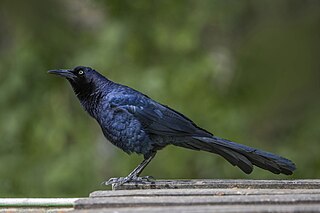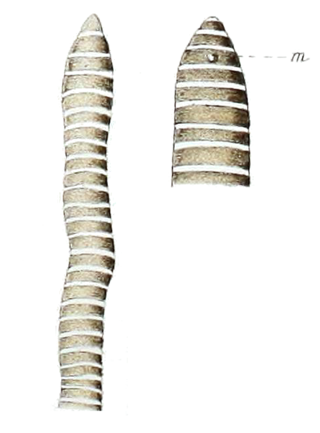
The Mexican tetra, also known as the blind cave fish, blind cave characin or the blind cave tetra, is a freshwater fish in the Characidae family of the order Characiformes. The type species of its genus, it is native to the Nearctic realm, originating in the lower Rio Grande, and the Neueces and Pecos Rivers in Texas, into the Central Plateau and eastern states of Mexico.

In moral and political philosophy, the social contract is an idea, theory or model that usually, although not always, concerns the legitimacy of the authority of the state over the individual. Conceptualized in the Age of Enlightenment, it is a core concept of constitutionalism, while not necessarily convened and written down in a constituent assembly and constitution.

Nemertea is a phylum of animals also known as ribbon worms or proboscis worms, consisting of 1300 known species. Most ribbon worms are very slim, usually only a few millimeters wide, although a few have relatively short but wide bodies. Many have patterns of yellow, orange, red and green coloration. The foregut, stomach and intestine run a little below the midline of the body, the anus is at the tip of the tail, and the mouth is under the front. A little above the gut is the rhynchocoel, a cavity which mostly runs above the midline and ends a little short of the rear of the body. All species have a proboscis which lies in the rhynchocoel when inactive but everts to emerge just above the mouth to capture the animal's prey with venom. A highly extensible muscle in the back of the rhynchocoel pulls the proboscis in when an attack ends. A few species with stubby bodies filter feed and have suckers at the front and back ends, with which they attach to a host.

Sharks are a group of elasmobranch fish characterized by a cartilaginous skeleton, five to seven gill slits on the sides of the head, and pectoral fins that are not fused to the head. Modern sharks are classified within the clade Selachimorpha and are the sister group to the Batoidea. Some sources extend the term "shark" as an informal category including extinct members of Chondrichthyes with a shark-like morphology, such as hybodonts. Shark-like chondrichthyans such as Cladoselache and Doliodus first appeared in the Devonian Period, though some fossilized chondrichthyan-like scales are as old as the Late Ordovician. The oldest confirmed modern sharks (selachimorphs) are known from the Early Jurassic, about 200 million years ago, though records of true sharks may extend back as far as the Permian.

The bonobo, also historically called the pygmy chimpanzee, is an endangered great ape and one of the two species making up the genus Pan. While bonobos are, today, recognized as a distinct species in their own right, they were initially thought to be a subspecies of Pan troglodytes, due to the physical similarities between the two species. Taxonomically, members of the chimpanzee/bonobo subtribe Panina—composed entirely by the genus Pan—are collectively termed panins.

Stingrays are a group of sea rays, a type of cartilaginous fish. They are classified in the suborder Myliobatoidei of the order Myliobatiformes and consist of eight families: Hexatrygonidae, Plesiobatidae, Urolophidae (stingarees), Urotrygonidae, Dasyatidae, Potamotrygonidae, Gymnuridae and Myliobatidae . There are about 220 known stingray species organized into 29 genera.

Chinchillas are either of two species of crepuscular rodents of the parvorder Caviomorpha, and are native to the Andes mountains in South America. They live in colonies called "herds" at high elevations up to 4,270 m (14,000 ft). Historically, chinchillas lived in an area that included parts of Bolivia, Peru and Chile, but today, colonies in the wild are known only in Chile. Along with their relatives, viscachas, they make up the family Chinchillidae. They are also related to the chinchilla rat.

Peromyscus is a genus of rodents. They are commonly referred to as deer mice or deermice, not to be confused with the chevrotain or "mouse deer". They are New World mice only distantly related to the common house and laboratory mouse, Mus musculus. From this relative, Peromyscus species are distinguished by relatively larger eyes, and also often two-tone coloring, with darker colors over the dorsum (back), and white abdominal and limb hair-coloring. In reference to the coloring, the word Peromyscus comes from Greek words meaning "booted mouse". They are also accomplished jumpers and runners by comparison to house mice, and their common name of "deer mouse" is in reference to this agility.

The Mexican prairie dog is a diurnal burrowing rodent native to north-central Mexico. Treatment as an agricultural pest has led to its status as an endangered species. They are closely related to squirrels, chipmunks, and marmots. Cynomys mexicanus originated about 230,000 years ago from a peripherally isolated population of the more widespread Cynomys ludovicianus.

The great-tailed grackle or Mexican grackle is a medium-sized, highly social passerine bird native to North and South America. A member of the family Icteridae, it is one of 10 extant species of grackle and is closely related to the boat-tailed grackle and the extinct slender-billed grackle. In the southern and southwestern United States, the grackle is sometimes referred to simply as a "blackbird" or (erroneously) a "crow" due to its glossy black plumage; however, grackles form their own unique genus that is separate from other "blackbirds", such as the red-winged and Brewer's blackbirds, despite being in the same family (Icteridae). Superficially, Brewer's blackbird is one of the most visually similar species to grackles.
The Georgia Tech Research Institute (GTRI) is the nonprofit applied research arm of the Georgia Institute of Technology in Atlanta, Georgia, United States. GTRI employs around 3,000 people, and was involved in nearly $1 billion in research in 2023 for more than 200 clients in industry and government.

Enopla is one of the classes of the worm phylum Nemertea, characterized by the presence of a peculiar armature of spines or plates in the proboscis.

The Mexican deer mouse is a species of forest-dwelling rodent in the family Cricetidae. It is found in southern Mexico and throughout much of Central America.

A French kiss, also known as cataglottism or a tongue kiss, is an amorous kiss in which the participants' tongues extend to touch each other's lips or tongue. A kiss with the tongue stimulates the partner's lips, tongue and mouth, which are sensitive to the touch and induce sexual arousal. The sensation when two tongues touch—also known as tongue touching—has been proven to stimulate endorphin release and reduce acute stress levels. Extended French kissing may be part of making out. The term originated at the beginning of the 20th century, in America and Great Britain, as the French had acquired a reputation for more adventurous and passionate sex practices.

Basaseachic Falls National Park is a national park located in the western side of the state of Chihuahua in the heart of the Sierra Madre Occidental mountain range. The park is named after Basaseachic Falls the second tallest waterfall in Mexico with a height of 246 meters (853 ft). Basaseachic Falls empties into Candameña Canyon which was carved by the Basaseachic River over millions of years. The park is known for its pine-oak forest, rock formations, and scenic views from high cliffs. Cliffs in the park reach an impressive height of 1,640 meters (5,380 ft).

Adhemarius mexicanus is a species of moth in the family Sphingidae. It was described by Manuel Artemio Balcázar-Lara and Carlos R. Beutelspacher in 2001, and is known from Mexico, where it is found from Oaxaca to Jalisco.
Prostoma jenningsi is a species of ribbon worm known only from one site near Croston, Lancashire. It was described in 1971, and is believed to be the county's only endemic species. It grows up to 20 mm (0.8 in) long, with 4–6 black eyespots, and has a long eversible proboscis.

Baseodiscus is a genus of nemerteans belonging to the family Valenciniidae.
















